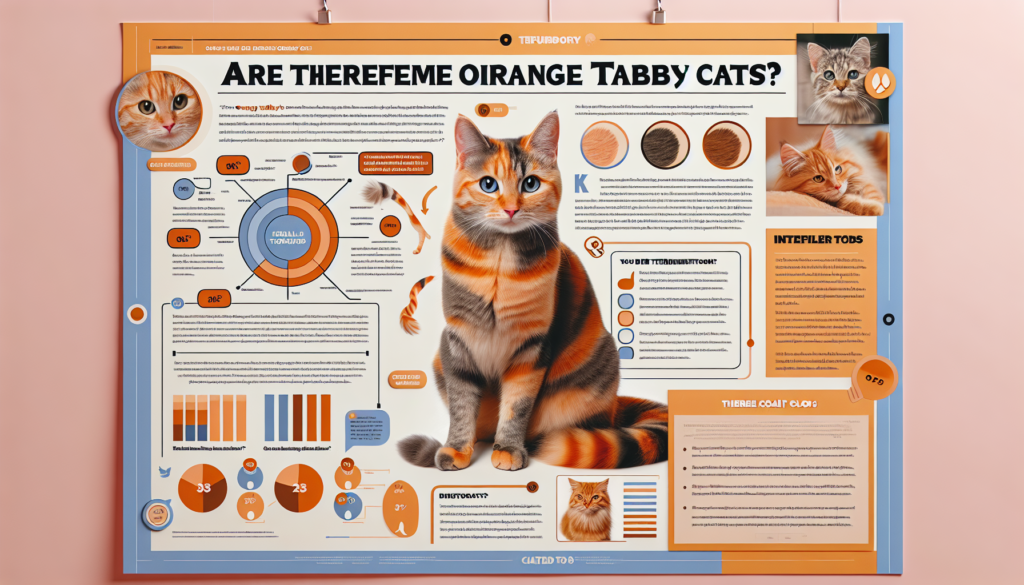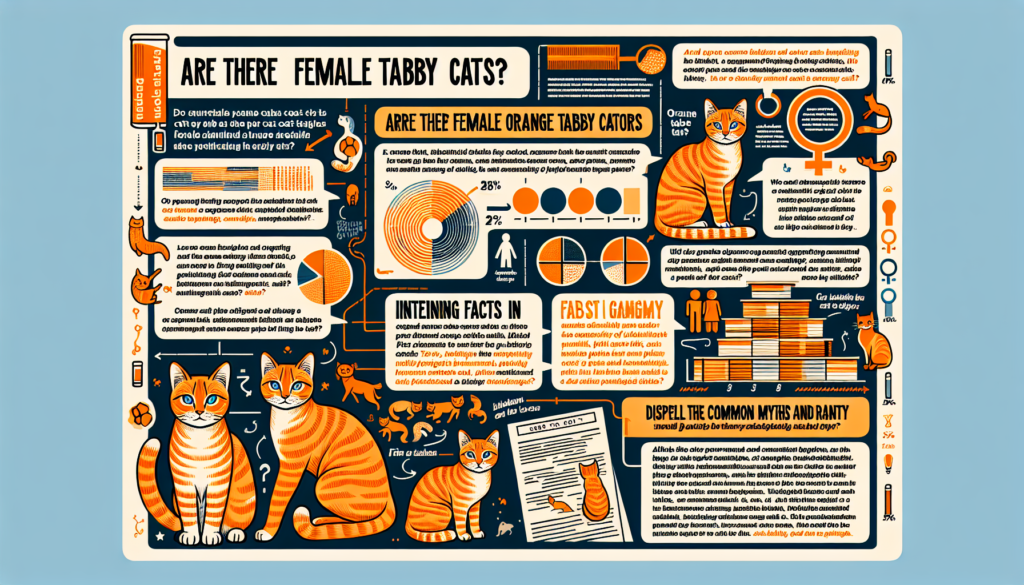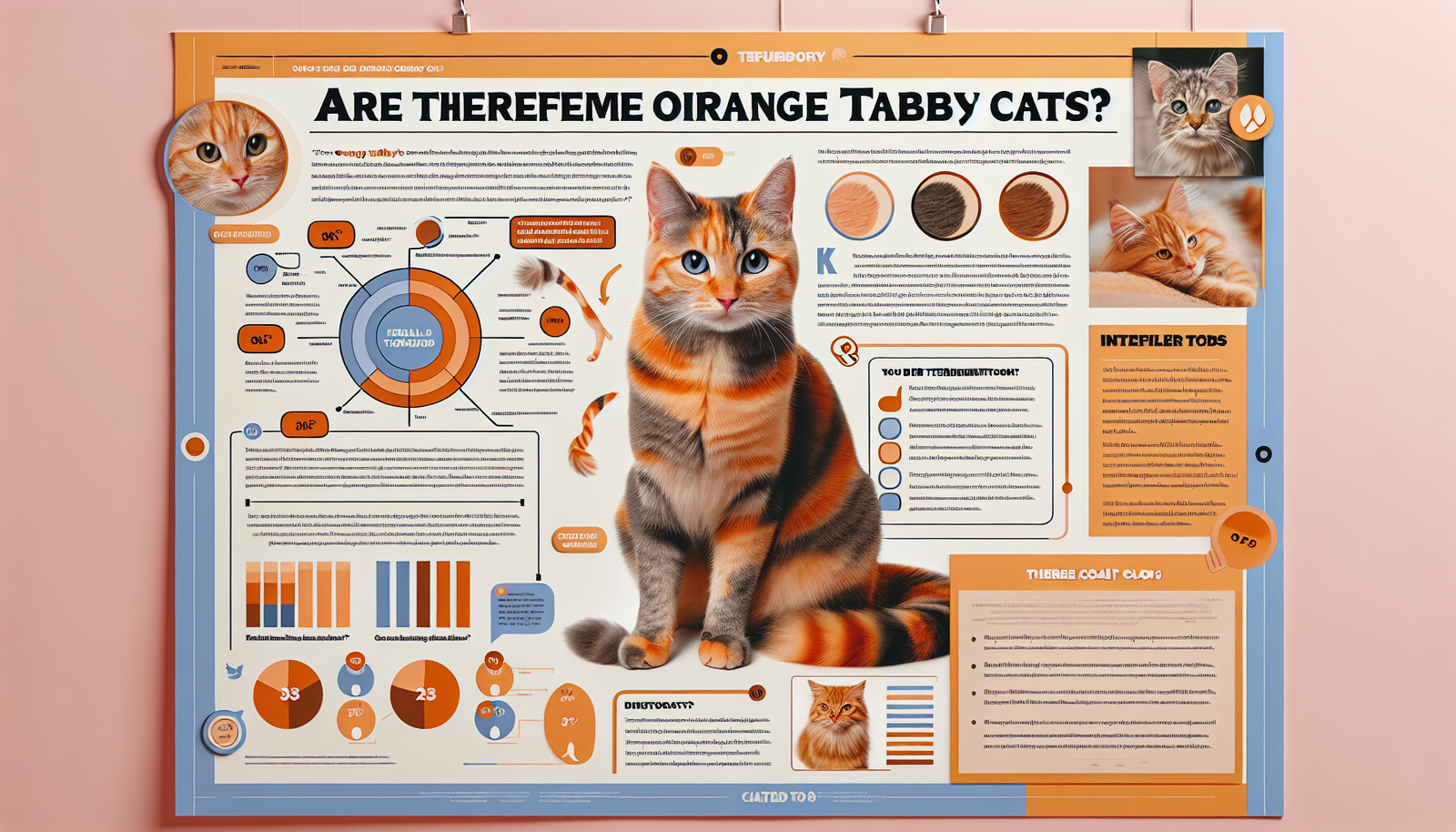Did you know that orange tabby cats are often incorrectly assumed to be male? Contrary to popular belief, female orange tabby cats do exist! While male orange tabbies are more common due to the genetics of coat color inheritance, female orange tabbies are still found in feline populations. In this article, we will explore the reasons behind the misconception, the genetic factors at play, and the various characteristics that distinguish female orange tabbies. So, if you’ve ever wondered about the existence of female orange tabby cats, read on to uncover the truth about these beautiful feline companions.

What is an Orange Tabby Cat?
Definition of an Orange Tabby Cat
An orange tabby cat, also known as a ginger cat or marmalade cat, is a domestic cat with a distinct coat color pattern. These cats have a vibrant orange or reddish coat with tabby markings, which are characterized by stripes, swirls, or spots on their fur. While orange tabby cats can come in various shades of orange, their tabby pattern is the defining feature that sets them apart.
Physical Characteristics of an Orange Tabby Cat
Orange tabby cats typically have medium to large-sized bodies, with a strong and muscular build. They have round faces, topped with alert ears, and expressive eyes that can be a range of colors, such as green, gold, or copper. Their coats are dense and soft, and the distinct tabby patterns can vary in intensity, from bold and clearly defined to more subtle markings.
Personality Traits of an Orange Tabby Cat
Beyond their striking appearance, orange tabby cats are well-known for their friendly and outgoing personalities. They are often described as sociable, affectionate, and playful companions. These cats enjoy interacting with their human family members and are generally easy-going and adaptable. Orange tabby cats have a reputation for being great with children and other pets, making them a wonderful addition to any household.
The Genetics of Orange Tabby Cats
How Coat Color is Determined in Cats
The coat color in cats is determined by a complex interaction of genetic factors. These factors influence the production and distribution of pigments in the fur. The genes responsible for coat color are passed down from the cat’s parents, with each parent contributing a set of genes to their offspring.
The Role of the X Chromosome
The X chromosome plays a significant role in determining coat color in cats. The gene responsible for the orange color in tabby cats is carried on the X chromosome. As a result, males only need to inherit one copy of the orange gene to display the orange coat color, while females need to inherit two copies to have an orange coat. This genetic distinction contributes to the gender differences observed in orange tabby cats.
Orange Tabby Cats and the Eumelanin Pigment
The eumelanin pigment, which is responsible for the black and brown colors in cat fur, interacts with the orange gene to create the distinct tabby patterns seen in orange tabby cats. The intensity of the eumelanin pigment in the fur determines the level of contrast between the orange and darker markings. Different variations of the orange gene can affect the eumelanin pigment’s interaction, resulting in variations in the tabby patterns seen in orange tabby cats.
Feline Genetics and Orange Tabby Coat Color
Feline genetics is a fascinating field that continues to unravel the complexities of coat color inheritance. While the orange tabby coat color is primarily determined by the interaction of the orange gene and the eumelanin pigment, other genes and genetic variations can influence the specific shades of orange and the patterns present in the fur. Researchers are continually studying these genetic factors to gain a deeper understanding of the inheritance patterns and variations observed in orange tabby cats.
Understanding Tabby Cat Patterns
The Tabby Cat Pattern
The tabby pattern, often referred to as the agouti pattern, is one of the most common coat patterns found in domestic cats. It is characterized by stripes, swirls, or spots on the cat’s fur. The tabby pattern can manifest in various colors, including orange, gray, brown, and black. This pattern is a naturally occurring camouflage adaptation, allowing cats to blend into their surroundings and providing effective protection.
Different Types of Tabby Patterns
Within the tabby pattern, there are several different variations that can be observed in cats. Some of the most common types of tabby patterns include classic, mackerel, spotted, and ticked. The classic tabby pattern displays bold, swirling patterns on the cat’s sides, while the mackerel pattern showcases thin, parallel stripes. Spotted tabbies have distinct spots or blotches on their fur, and ticked tabbies have individual hairs that alternate between two or more colors.
Does the Tabby Pattern Depend on Gender?
The tabby pattern is not directly determined by gender in cats. Both male and female cats can exhibit tabby patterns, including the orange tabby pattern. However, as mentioned earlier, the orange coat color is more commonly seen in male orange tabby cats due to the specific inheritance of the orange gene on the X chromosome. Female orange tabby cats require two copies of the orange gene to display the orange coat color, which occurs less frequently.
Orange Tabby Cat Gender Ratio
Is the Orange Tabby Color Linked to Gender?
While male orange tabby cats are more prevalent, the orange tabby color itself is not linked solely to gender. The genetic mechanisms and the inheritance of the orange gene determine the distribution of orange tabby cats among males and females. The presence of female orange tabby cats depends on the combination of genetic factors present in their parents.
Male Orange Tabby Cats
Male orange tabby cats have a higher chance of displaying the orange coat color due to their unique genetic inheritance. They only need to inherit one copy of the orange gene, which is carried on the X chromosome, from either their mother or father to have an orange tabby coat. As a result, approximately 80% of orange tabby cats are male, making them more common than their female counterparts.
Female Orange Tabby Cats
Female orange tabby cats, on the other hand, require both parents to pass on the orange gene for them to have an orange coat color. This genetic combination is less common, leading to a smaller number of female orange tabby cats compared to males. Female orange tabbies are a cherished rarity and a delight to those fortunate enough to encounter them.
Frequency of Female Orange Tabby Cats
While female orange tabby cats are less common, they can still be found. The frequency of female orange tabbies may vary depending on the specific genetic makeup of the cat population being considered. In some regions or breeding programs, the occurrence of female orange tabbies may be slightly higher. Regardless of their rarity, female orange tabby cats captivate with their unique beauty and charm.

Myths and Misconceptions
Myth: Orange Tabby Cats are Always Male
One common misconception is that all orange tabby cats are male. While male orange tabbies do outnumber females, it is incorrect to assume that all orange tabby cats are male. Female orange tabby cats do exist and can exhibit the same vibrant orange coat color and tabby patterns as their male counterparts.
Breaking the Stereotype: Female Orange Tabby Cats Exist
Female orange tabby cats are a wonderful example of breaking stereotypes. They serve as a reminder that gender does not solely determine coat color or pattern in cats. Female orange tabbies showcase the diversity and beauty that can be found within feline genetics and challenge the notion that certain coat colors are exclusive to a particular gender.
Misconceptions about Female Orange Tabby Cats
Due to the relative rarity of female orange tabby cats, there are often misconceptions surrounding their existence. Some people may mistakenly believe that female orange tabbies are sterile or possess health issues. However, there is no scientific evidence to support these claims. Female orange tabbies are generally as healthy and capable of reproduction as any other cat, and their rarity adds to their charm and allure.
Factors Influencing Coat Color in Female Orange Tabby Cats
Genetic Factors
The coat color in female orange tabby cats is primarily influenced by genetic factors. As mentioned earlier, they require two copies of the orange gene, which is carried on the X chromosome, to display the orange coat color. The combination of genes inherited from their parents determines the specific shade of orange and the pattern of their fur.
Hormonal Factors
Hormonal factors can also play a role in the coat color expression of female orange tabby cats. During heat cycles, hormonal changes may affect the intensity or appearance of their coat color. Some female cats may experience a lightening or darkening of their fur during these cycles. Additionally, pregnancy and certain medical conditions can influence coat color due to hormonal fluctuations.
Variations in Female Orange Tabby Coat Colors
Dilute Calico Tabby
One variation of female orange tabby coat color is the dilute calico tabby. Calico cats are characterized by a tri-color pattern of orange, black, and white, while the dilute calico tabby showcases softer, muted variations of these colors. The combination of the orange tabby pattern with the dilute calico coloring creates an exquisite and unique coat for female orange tabby cats.
Tortoiseshell Tabby
Another stunning variation is the tortoiseshell tabby. Tortoiseshell cats, also known as “torties,” exhibit a mix of orange, black, and sometimes white patches on their fur. When combined with the tabby pattern, these patches can create a beautiful mosaic of colors and patterns that distinguishes female orange tabbies.
Patchy Orange Tabby
Some female orange tabby cats may display a patchy variation of the orange tabby pattern. This occurs when the orange coat color is concentrated in certain areas, creating patches or spots of orange on the cat’s fur. The contrast between the orange patches and the background color adds an intriguing element to their appearance.
Classic Orange Tabby
Finally, some female orange tabby cats may exhibit the classic orange tabby pattern without any dilution or mixture of colors. These cats have a solid orange coat color with distinct tabby markings, showcasing the beauty and simplicity of the orange tabby pattern.
Famous Female Orange Tabby Cats
Celebrity Cats in Pop Culture
Throughout history, several female orange tabby cats have gained fame and captured the hearts of many. One notable celebrity cat is Garfield, a beloved cartoon character known for his love of lasagna and sarcastic personality. Garfield has become an iconic representation of the lovable and mischievous nature often associated with orange tabby cats.
Social Media Sensations
With the rise of social media, many female orange tabby cats have become internet sensations. Delighting audiences with their adorable antics and captivating personalities, these cats have amassed a large following. From adventurous explorers to snuggly companions, these social media stars shine a spotlight on the beauty and charm of female orange tabbies.
Historical Female Orange Tabby Cats
Though not as widely known, female orange tabby cats have left their mark throughout history as well. Some notable historical figures, such as Queen Elizabeth I of England, were known to have a fondness for orange tabby cats. These cats were cherished companions and even depicted in portraits, showcasing their significance and valued place in society.
Adopting a Female Orange Tabby Cat
Finding a Female Orange Tabby Cat
If you are interested in adopting a female orange tabby cat, there are several avenues to explore. Local animal shelters or rescue organizations often have a variety of cats available for adoption, including orange tabby cats. Additionally, reaching out to reputable breeders or networking within the cat community may lead to finding a female orange tabby cat in need of a loving home.
Considerations before Adoption
Before adopting a female orange tabby cat, it is essential to consider various factors. Ensure that you have the time, space, and resources to provide for a cat’s needs. Research the specific care requirements of orange tabby cats and be prepared for the responsibilities of pet ownership. Additionally, consider any existing pets or family members and their compatibility with a new feline addition.
Caring for a Female Orange Tabby Cat
Caring for a female orange tabby cat is similar to caring for any other domestic cat. Provide a balanced diet, regular veterinary care, and plenty of mental and physical stimulation. As social creatures, orange tabby cats thrive on human interaction, so be sure to dedicate time for play, affection, and bonding. Creating a safe and enriched environment will ensure a happy and healthy life for your female orange tabby cat.
Conclusion
Female orange tabby cats are unique and captivating creatures that challenge stereotypes and misconceptions. While they may be less common than their male counterparts, their rarity adds to their charm and allure. Understanding the genetic and hormonal factors that influence their coat color enriches our appreciation for their beauty. Whether you are a fan of their striking appearance or drawn to their friendly personalities, female orange tabby cats truly embody the best qualities of feline companionship. If you are considering adding a female orange tabby cat to your family, be prepared for a lifetime of love, laughter, and joy with these remarkable feline friends.

